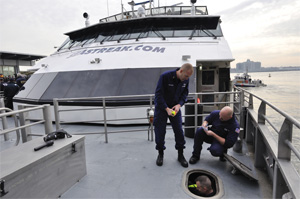The National Transportation Safety Board (NTSB) wants U.S. ferry operators to do more to keep passengers from stairwells during docking, undocking and other potentially dangerous maneuvers.
The agency has issued a safety alert that reminds passengers to avoid stairways and stay seated during the docking and undocking. The alert urges operators to find ways to control access to stairwells during these times.
The alert followed an investigation into a January 2013 incident in which the high-speed catamaran Seastreak Wall Street ran into a pier while docking in New York City. The accident injured 80 people, four seriously. Many of the injured passengers had crammed into stairwells in a rush to get off.
Tracy Murrell, director of the NTSB’s Office of Marine Safety, said in a phone interview that operators should develop a safety management system that includes strategies for keeping passengers from entering stairwells during docking and undocking. She said these policies should be developed to meet the characteristics of individual vessels.
So what strategies work?
Announcements reminding passengers to avoid stairways during departures and arrivals have proven effective for many ferry operators, she said. Installing visual cues such as warning signs in stairwells and hallways also helps get the message across.
Some operators will go even further, temporarily blocking access to non-emergency egresses during docking with a rope or removable barrier, she said. Stationing crewmembers at the bottom of stairways is another way to improve compliance.
“It’s up to the operators to remind passengers to be proactive to avoid having passengers congregate in an area where they could be hurt if the vessel comes to an abrupt stop,” Murrell said.
She acknowledged what many ferry operators already know: Some passengers ignore or disregard safety messages, especially when they are in a hurry to get off.
“It is a challenge,” Murrell said, adding that operators have a responsibility for passenger safety, even when passengers will not cooperate. “It can be difficult to get people to take responsibility for their own safety.”
In these cases, she said, it is imperative that crew know the policies and make sure they are enforced, even if that means confronting passengers not following the rules.
“People tend to follow the crowd,” she said. “If they are not following the rules, and nobody is taking action, more people are likely to follow suit.”
Seastreak Wall Street was traveling at about 12 knots when it struck a pier in Lower Manhattan at about 0841 on Jan. 9, 2013. The report said the captain lost control of the vessel while moving from one bridge control station to another.
Investigators determined the captain was unaware the vessel’s propulsion system was in backup mode. As a result, his efforts to slow the vessel to prepare for docking actually caused it to accelerate, the report said.
One passenger fell down a staircase and hit the overhead section of the stairwell structure when the vessel struck the pier on its starboard side. He suffered a broken neck, brain hemorrhage, lung collapse and other serious injuries, and was hospitalized for five weeks.
A passenger standing halfway down a starboard outboard stairwell broke three ribs, while another fell down 10 steps and suffered a head laceration and concussion, the report said. The other serious injury involved a passenger who suffered a fractured shoulder blade.
“The NTSB concludes that the number and severity of injuries resulting from this accident could have been mitigated by alerting passengers and controlling their access to stairwells during docking and undocking,” the report said.
Seastreak Wall Street did not have a safety announcement over its public address system urging passengers to avoid stairways during docking. In this case, the captain told investigators he had no time to warn passengers before impact.
Seastreak has since adopted new procedures for its four high-speed ferries. They include a safety message prior to arrival that directs passengers to stay out of stairwells, the report said. The message dispatches crew to disembarkation stations within the vessel.
Seastreak officials declined to comment. Questions emailed to the company’s marketing director at his request were not answered.
John Groundwater, executive director of the Passenger Vessel Association (PVA), said operators often have clear policies concerning where passengers can congregate aboard the vessel. He said deck crew is charged with enforcing these policies.
Additionally, he said operators train their crews in crowd management techniques and practices for situations such as this.
“U.S. passenger ferry operators have long focused on ensuring passenger safety in stairwells and all other public areas,” Groundwater said in a written statement. “Rigorous crew training and constant attention to continuous improvement over many years (have) produced a safety record that is second to none in the maritime industry.”
He acknowledges passenger behavior and compliance with safety warnings can be unpredictable. In those situations, he said “vigilance on the part of operators and crew” is required to maintain safety.
The PVA is developing a new safety management system called Flagship that’s intended to help operators maintain safety on their vessels during these and other circumstances.
“A strong culture of safety permeates the U.S. ferry industry,” Groundwater said, “and protecting the well-being of passengers is at the core of this philosophy.”

